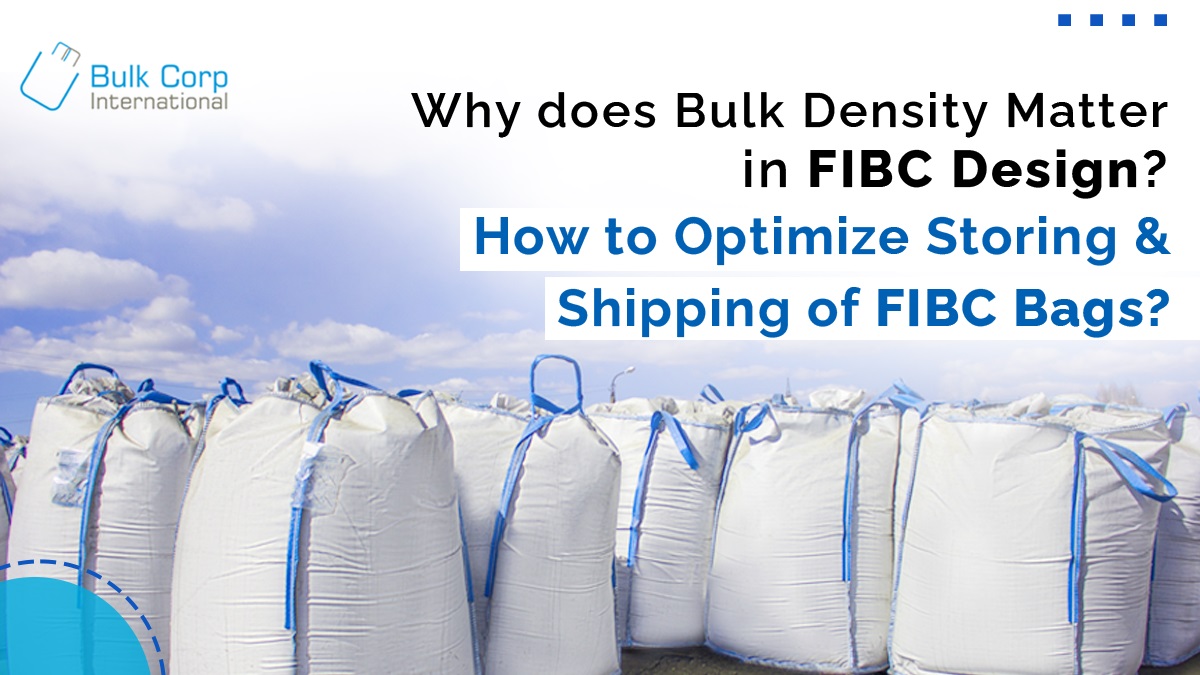Why does Bulk Density Matter in FIBC Design? How to Optimize Storing and Shipping of FIBC Bags?

Bulk Density plays a vital role in FIBC Industry, especially in FIBC Bag Manufacturing. It is a frequently used term by FIBC Bag Manufacturers and users. Bulk Density is a crucial attribute in making an FIBC Bag for dry-flowable goods.
What is Bulk Density?
A product’s Bulk Density is its mass per unit volume of powdery substances or fine granules when it is in a bulk state.
A substance Bulk Density is used to determine the number of particles or substances we can fit in that defined amount of space (FIBC Bulk Bag) safely and conveniently.
In this blog, we will walk you through why FIBC Bulk Density matters in an FIBC design, and also we will give you tips on how to optimize storing and shipping of FIBC bags.
Why does Bulk Density matter in FIBC Design?
A product’s Bulk Density influences a wide variety of design choices, from filling to discharging options you implement to the overall size of your FIBC Bag.
If we ignore or neglect the substance’s Bulk Density, we will fall short of FIBC Bags and give rise to situations where we might put our customers in a dangerous position due to the bag’s performance. Hence, failing to understand a product’s Bulk Density is an unsafe long-term storage option.
Under or Over estimate of Bulk Density of products or materials can lead to improper estimation of target weight per bag. It can lead to downstream shipping processes, resulting in varying and incorrect storage requirements, putting people in jeopardy handling these systems.
The Bulk Density of products & materials can fluctuate due to real-world conditions. Staying updated on real-world situations can help mitigate product filling, storing, shipping, and safety issues.
Opting for compaction during storage will lead to the product taking up a lot of headspaces. It can be misleading during the filling process, making you think the bag holds fewer products or materials than the standard amount.
The intrusion of moisture during storing and transporting, especially during wet or humid environments, can modify a product’s Bulk Density, resulting in a heavier weight of products than the estimated one.
Hence, it is vital to pay utmost attention to the Bulk Density in FIBC Design.
How to optimize storing and shipping of FIBC Bags?
After knowing why Bulk Density matters, let us walk you through the tips for optimizing storing and shipping of FIBC Bags by avoiding Bulk Density issues.
Opt for coating or liners for prevention from external contamination
Coating and Liners are the two most effective ways to prevent the intrusion of external contaminants inside the bag. While storing and transporting materials inside the FIBC Bulk Bags in humid or wet conditions, the product’s Bulk Density can be affecte FIBC Bulk Bags designed with built-in poly liners or coating will help alleviate possible changes to the product’s Bulk Density. Poly Liners work best with spout top or duffel top FIBC Bags and can even be attached to the inner or outside of the bag to ensure the liner itself does not discharge.
Go a little overestimate with FIBC Bag strength
While customizing FIBC Bulk Bags, we recommend going a little overboard with FIBC Bag strength and selecting a safety factor of 5:1 or 6:1 to ensure your Bag safety won’t be compromised, irrespective of the product’s Bulk Density.
It will play a crucial role, especially during storing and transporting of products in humid and wet environments, where alter in the product’s Bulk Density won’t affect the bag performance significantly.
Opt for an ideal Discharge option
Many buyers often miss out on paying importance to the selection of Discharging option while they pay utmost attention to the selection of the Filling top. Depending on the material you will fill inside the bag, opt for the discharge option.
E.g., if you are filling cement or sand for the construction, you can opt for Discharge Spout for discharging materials in an alignment. However, a full-drop discharge option might be useful if you are filling barley or maize.
Conclusion
After reading the entire blog, you will have comprehensible clarity about what bulk density is, why it is important in FIBC design, and how to optimize storing and shipping FIBC bags.
At Bulkcorp International, we help all our clients select the correct Bulk Density of the FIBC Bag based on their requirements and the products they will fill inside the bag. We also share best practices for using FIBC Bulk Bags and tips for safely and efficiently handling FIBC bags.
For any questions regarding FIBC Bags Bulk Density, contact us at enquiry@bulkcorp-int.com or call at +91-79-3533 6805 or +91-79-3533 6804.





